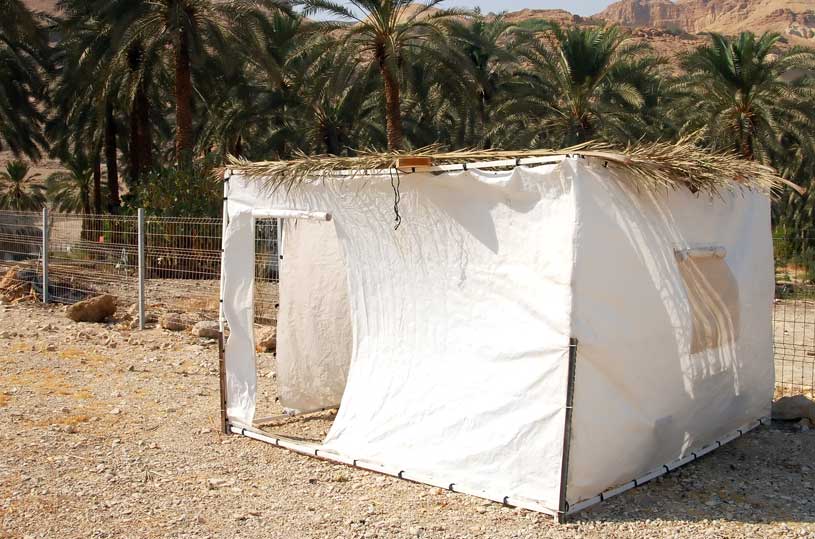Rav Yitzchak Hutner[2] points out that the Festivals do not exist in isolation from each other, rather they are categorized together in two different groupings: One is the Shalosh Regalim, consisting of Pesach, Shavuos, and Sukkot. The Torah explicitly mentions Sukkot as the final Regel after Pesach and Shavuos. It represents the final stage in the agricultural process, when the food is gathered in, hence one of the names of Sukkot is Chag HaAsif – the festival of gathering.
The second grouping is Rosh HaShana, Yom Kippur, and Sukkot. This combination is explained by Chazal: In discussing the Mitzva of the Four Species, the Midrash[3] explains that when someone has a court case against him, one way to know whether or not he has been successful is to see if he leaves the court waving his weapons as a sign of triumph.
Accordingly, we wave our lulav as indication of our confidence that HaShem has accepted our teshuva on Yom Kippur and we have been forgiven. This Midrash demonstrates a strong connection between Sukkot and the Yamim Noraim, namely that Sukkot represents a culmination of the teshuva that we have done on those days[4].
These sources teach us that Sukkot is a ‘double Yom Tov’ in the sense that it is part of two joyous groups of days. Rav Immanuel Bernstein, shlit’a, explains that this is a possible reason as to why Sukkot is described as Zman Simchateinu more than the other Festivals. It is not only the culminating Festival of the Shalosh Regalim, but is also the crowning event after the Yamim Noraim. Thus, in fact it is possible to say that Sukkot is actually two Festivals rolled into one.
A fascinating support for this idea is seen by contrasting the Korbanos brought in the Mussaf offerings for Sukkot as opposed to those of the other Festivals. On all the other Festivals, seven lambs are offered, but on Sukkot, fourteen are brought. This double measure of Mussaf offerings serves to establish that Sukkot is actually two Festivals in one[5].
It is possible to add that the unique role of Sukkot in both of these groupings is that it is the culmination of sequences, and it is this culmination that also seems to play a key role in the extra emphasis on joy at this time.
Interestingly, Sukkot is connected to a third conclusory cycle: Chazal decreed that the day of Shemini Atseres, which is intrinsically connected to Sukkot and ends the sequence of Festivals, is also the day when the cycle of Torah learning is completed; Simchas Torah. This again indicates that the joy that is unique to Sukkah is that of completion.
In truth, it seems that that the very beginning of the Torah teaches the significance of the completion of processes. The Ramban[6] notes that at the end of each of the seven days of Creation the Torah states that HaShem saw that it was ’tov’ – good, with the exception of the second day. The Ramban, based on the Midrash[7], explains that something is described as ‘tov’ when it reaches its completion.
On the second day, the creation of the water began but it was not completed until the third day. Hence, there was no mention of it being tov at the end of the second day, whereas for the third day, it says it was tov twice, first for the completion of the waters and again for the creation of plant life. This teaches us that goodness is defined as reaching completion. Hence, it is not surprising that it also a cause of great joy.
However, this idea that reaching completion is a source of joy does not mean that one should rest on his laurels after having completed a process. Rather, we must start again but on a higher level, reaching new heights. This is most exemplified by the fact that on Simchat Torah, immediately upon completing the Torah, we start again. We also see this immediately after Yom Kippur. We pray Maariv, and say the blessing of ‘selach lanu’ asking for forgiveness. This demonstrates that after we’ve completed a long process of teshuva, we don’t take a break, rather we start again right away[8].
May we all merit to derive true joy from the culmination of the Shalosh Regalim and Yamim Noraim, and begin again on a whole new level.
Facebook Twitter Youtube. Ce site utilise des cookies pour améliorer votre expérience. Nous supposerons que cela vous convient, mais vous pouvez vous désabonner si vous le souhaitez. https://www.cialispascherfr24.com/ Politique de confidentialité.





